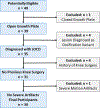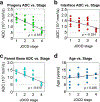Evaluation of lesion and overlying articular cartilage in patients with juvenile osteochondritis dissecans of the knee using quantitative diffusion MRI
- PMID: 36484124
- PMCID: PMC11756259
- DOI: 10.1002/jor.25505
Evaluation of lesion and overlying articular cartilage in patients with juvenile osteochondritis dissecans of the knee using quantitative diffusion MRI
Abstract
Current clinical MRI of patients with juvenile osteochondritis dissecans (JOCD) is limited by the low reproducibility of lesion instability evaluation and inability to predict which lesions will heal after nonoperative treatment and which will later require surgery. The aim of this study is to verify the ability of apparent diffusion coefficient (ADC) to detect differences in lesion microstructure between different JOCD stages, treatment groups, and healthy, unaffected contralateral knees. Pediatric patients with JOCD received quantitative diffusion MRI between January 2016 and September 2020 in this prospective research study. A disease stage (I-IV) and stability of each JOCD lesion was evaluated. ADCs were calculated in progeny lesion, interface, parent bone, cartilage overlying lesion, control bone, and control cartilage regions. ADC differences were evaluated using linear mixed models with Bonferroni correction. Evaluated were 30 patients (mean age, 13 years; 21 males), with 40 JOCD-affected and 12 healthy knees. Nine patients received surgical treatment after MRI. Negative Spearman rank correlations were found between ADCs and JOCD stage in the progeny lesion (ρ = -0.572; p < 0.001), interface (ρ = -0.324; p = 0.041), and parent bone (ρ = -0.610; p < 0.001), demonstrating the sensitivity of ADC to microstructural differences in lesions at different JOCD stages. We observed a significant increase in the interface ADCs (p = 0.007) between operative (mean [95% CI] = 1.79 [1.56-2.01] × 10-3 mm2 /s) and nonoperative group (1.27 [0.98-1.57] × 10-3 mm2 /s). Quantitative diffusion MRI detects microstructural differences in lesions at different stages of JOCD progression towards healing and reveals differences between patients assigned for operative versus nonoperative treatment.
Keywords: juvenile osteochondritis dissecans; knee joint; magnetic resonance imaging; osteochondral lesion; quantitative diffusion MRI.
© 2022 Orthopaedic Research Society. Published by Wiley Periodicals LLC.
Figures







References
-
- Laor T, Zbojniewicz AM, Eismann EA, et al. 2012. Juvenile osteochondritis dissecans: is it a growth disturbance of the secondary physis of the epiphysis? AJR Am J Roentgenol. 199:1121–1128. - PubMed
-
- Ellermann J, Johnson CP, Wang L, et al. 2017. Insights into the Epiphyseal Cartilage Origin and Subsequent Osseous Manifestation of Juvenile Osteochondritis Dissecans with a Modified Clinical MR Imaging Protocol: A Pilot Study. Radiology. 282:798–806. - PubMed
-
- Kijowski R, Blankenbaker DG, Shinki K, et al. 2008. Juvenile versus adult osteochondritis dissecans of the knee: appropriate MR imaging criteria for instability. Radiology. 248:571–578. - PubMed
-
- Kessler JI, Nikizad H, Shea KG, et al. 2014. The demographics and epidemiology of osteochondritis dissecans of the knee in children and adolescents. Am J Sports Med. 42:320–326. - PubMed
-
- Olstad K, Ekman S, Carlson CS. 2015. An Update on the Pathogenesis of Osteochondrosis. Vet Pathol. 52:785–802. - PubMed
Publication types
MeSH terms
Grants and funding
LinkOut - more resources
Full Text Sources

